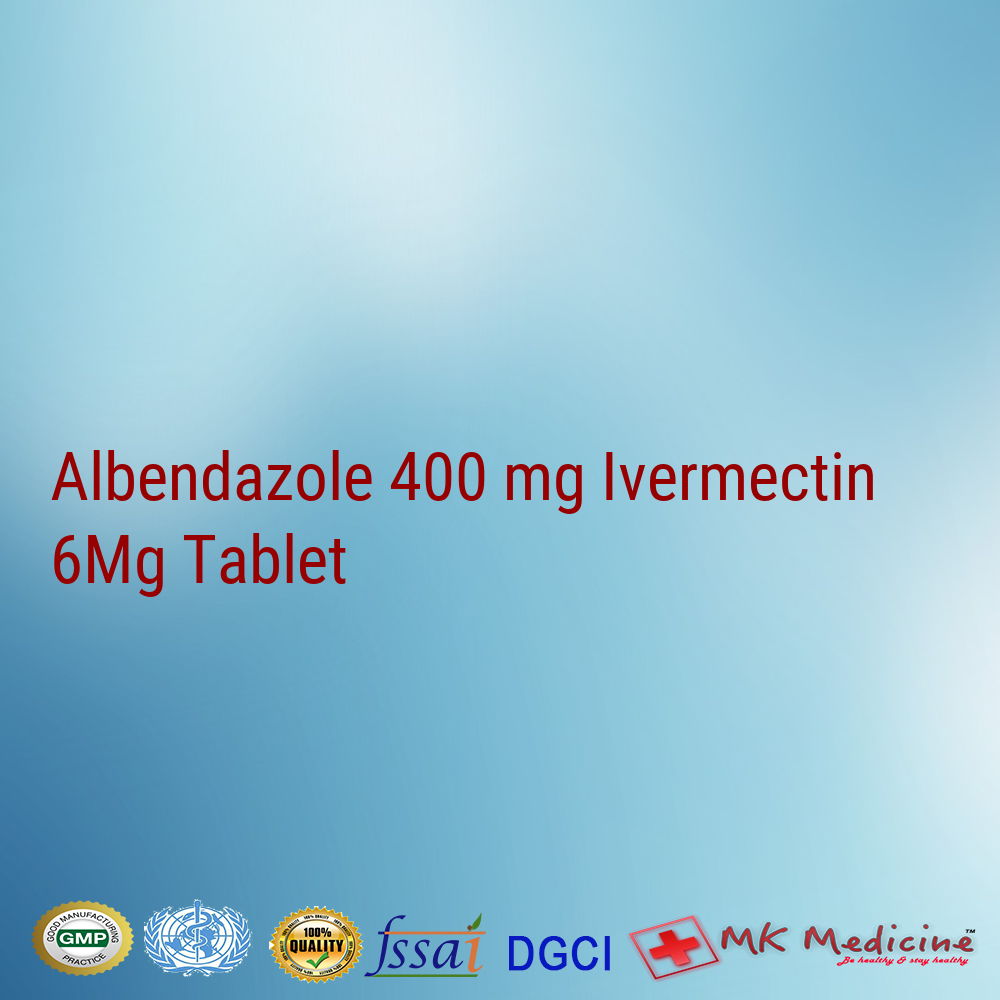Before knowing its combination , first we should need to know how they work individually and we know that Ivermectin is a broad-spectrum antiparasitic medicine and effective against worm infestations (such as strongyloidiasis, ascariasis, trichuriasis, filariasis, enterobiasis and Albendazole is used as a drug indicated for the treatment of a variety of worm infestations. It is a broad spectrum anthelmintic, effective against roundworms, tapeworms, and flukes of humans.
It has been demonstrated by recent studies concomitant administration of Ivermectin and Albendazole suspension, shows better symptoms relief compared with modest improvement of onchocerciasis some worm infestations like ascariasis, trichuriasis, filariasis. It is also effective against Flatworms, Flukes, Fasciolosis, Tapeworm, Cysticercosis, Echinococcosis and Hook worms.
MK Medicine is a leading pcd franchise provider, contract manufacturer and hospital supplier of WHO-GMP certified Albendazole 400 mg Ivermectin 6Mg Tablet
Albendazole :
Nausea, vomiting, abdominal pain, headache, or temporary hair loss may occur. If any of these effects last or get worse, tell your doctor or pharmacist promptly.
Remember that your doctor has prescribed this medication because he or she has judged that the benefit to you is greater than the risk of side effects. Many people using this medication do not have serious side effects.
Tell your doctor right away if you have any serious side effects, including: severe headache that doesn‚t go away, vision changes, yellowing eyes/skin, severe stomach/abdominal pain, dark urine, unusual tiredness, easy bruising/bleeding, signs of infection (such as sore throat that doesn‚t go away, fever, chills), signs of kidney problems (such as change in the amount of urine), confusion, very stiff neck.
Get medical help right away if you have any very serious side effects, including: seizures.
A very serious allergic reaction to this drug is rare. However, get medical help right away if you notice any symptoms of a serious allergic reaction, including: rash, itching/swelling (especially of the face/tongue/throat), severe dizziness, trouble breathing.
This is not a complete list of possible side effects. If you notice other effects not listed above, contact your doctor or pharmacist.
Ivermectin :
- Fever, itching or skin rash
- joint or muscle pain
- painful and tender glands in neck, armpits, or groin
- rapid heartbeat
● Abdominal pain
● Dizziness
● Headache
● Nausea
● Vomiting
Ivermectin and other avermectins (insecticides most frequently used in home-use ant baits) are macrocyclic lactones derived from the bacterium Streptomyces avermitilis. Ivermectin kills by interfering with nervous system and muscle function, in particular by enhancing inhibitory neurotransmission.
The drug binds and activates glutamate-gated chloride channels (GluCls). GluCls are invertebrate-specific members of the Cys-loop family of ligand-gated ion channels present in neurons and myocytes. After albendazole(ABZ) is administered, intestinal and hepatic albendazole metabolism leads to albendazole sulfoxide (active metabolite) and albendazole sulfone (inactive metabolite) formation. The metabolism albendazole sulfoxide effects as the active substance against the worms, albendazole sulfone has no active affection. Therefore albendazole sulfoxide anthelmintic function is better than albendazole.
Ivermectin can be given either by mouth or injection. It does not readily cross the blood–brain barrier of mammals due to the presence of P-glycoprotein, although crossing may still become significant if it is given at high doses (in which case, brain levels peak 2–5 hr after administration). In contrast to mammals, ivermectin can cross the blood–brain barrier in tortoises, often with fatal consequences.
Absorption: Albendazole is poorly absorbed from the GI tract; however, it is rapidly converted to its primary active metabolite, albendazole sulfoxide, prior to reaching systemic circulation. Fatty meals enhance bioavailability, as indicated by up to a 5-fold increase in plasma concentration in albendazole sulfoxide. Albendazole sulfoxide plasma concentrations are dose-dependent. C max is achieved in 2 to 5 h and ranges from 0.46 to 1.58 mcg/mL, when given with a fatty meal.
Distribution: Albendazole sulfoxide is 70% protein bound and widely distributed throughout the body.
Metabolism: After metabolism in the liver to albendazole sulfoxide, it is further metabolized to albendazole sulfone and other oxidative metabolites.
Elimination: Albendazole sulfoxide elimination half-life is 8 to 12 h. Biliary elimination of albendazole sulfoxide results in biliary concentrations similar to plasma concentration. Urinary excretion is a minor elimination pathway (less than 1%).
Important Notice:- The Database is still under development and may contain inaccuracies. It is not intended as a substitute for the expertise and judgement of your physician, pharmacist or other healthcare professional. It should not be construed to indicate that the use of any medication in any country is safe, appropriate or effective for you. Consult with your healthcare professional before taking any medication.


Albendazole IP 400 mg Tablet